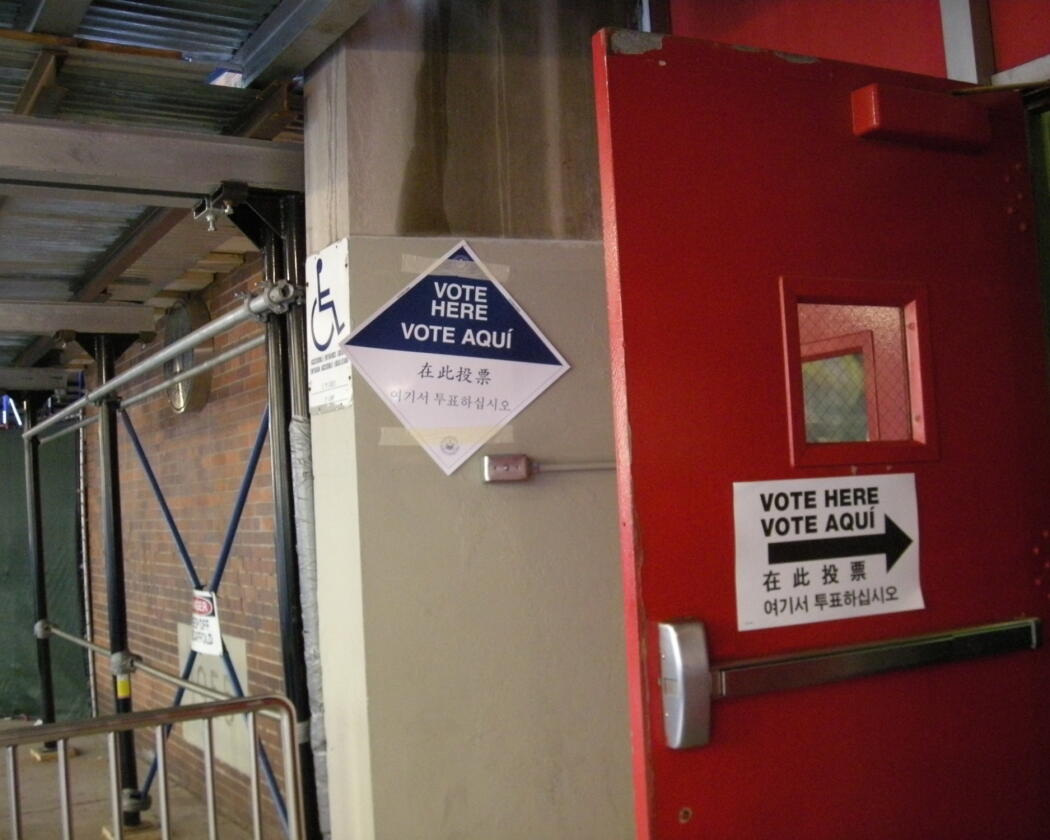
What the candidates for mayor have to say about New York’s landmark climate housing law
Local Law 97 has been up for discussion at the past few mayoral debates. Who we elect on November 4 will decide the policy’s fate.
Signs indicate the entrance to a NYC polling place. Photo: Flickr/Jessie Daniels
As New York City approaches Election Day to select its next mayor, we’ve spent the last nearly ten months watching candidates state and debate their stances on everything from public safety, to housing, to which parades have the right to exist. Yet one topic that’s often been overlooked is the city’s clean energy transition: What will become of the climate laws New York has passed so far, and will the next mayor advance these goals, or stall them?
In the final debates leading up to the start of early voting on October 25, the candidates were asked just a few glancing questions about their plans regarding Local Law 97 (LL97), New York City’s landmark climate housing law. Here, Skylight has compiled a comprehensive accounting of where the candidates stand, based on all they’ve said on the campaign trail. Democratic nominee Zohran Mamdani and independent candidate Andrew Cuomo have stated that they support the law, but differ in their views on its implementation; Republican candidate Curtis Sliwa has stated that he is opposed to it. These answers are not so cut and dry as they might seem, and who we elect will have an outsized impact on the city’s ability to meet its Net Zero goals on time.
First, for context: What is Local Law 97?
Local Law 97 (LL97) is a 2019 law that requires buildings larger than 25,000 square feet to begin the process of decarbonization, or reducing the amount of greenhouse gas (GHG) emissions produced by burning fossil fuels. The law was put in place because buildings are responsible for over two-thirds of New York City’s carbon emissions. LL97 aims to nudge our biggest buildings, which are the largest carbon contributors, to start overhauling their operations, with a goal of reducing the city’s overall GHG emissions to net zero by 2050.
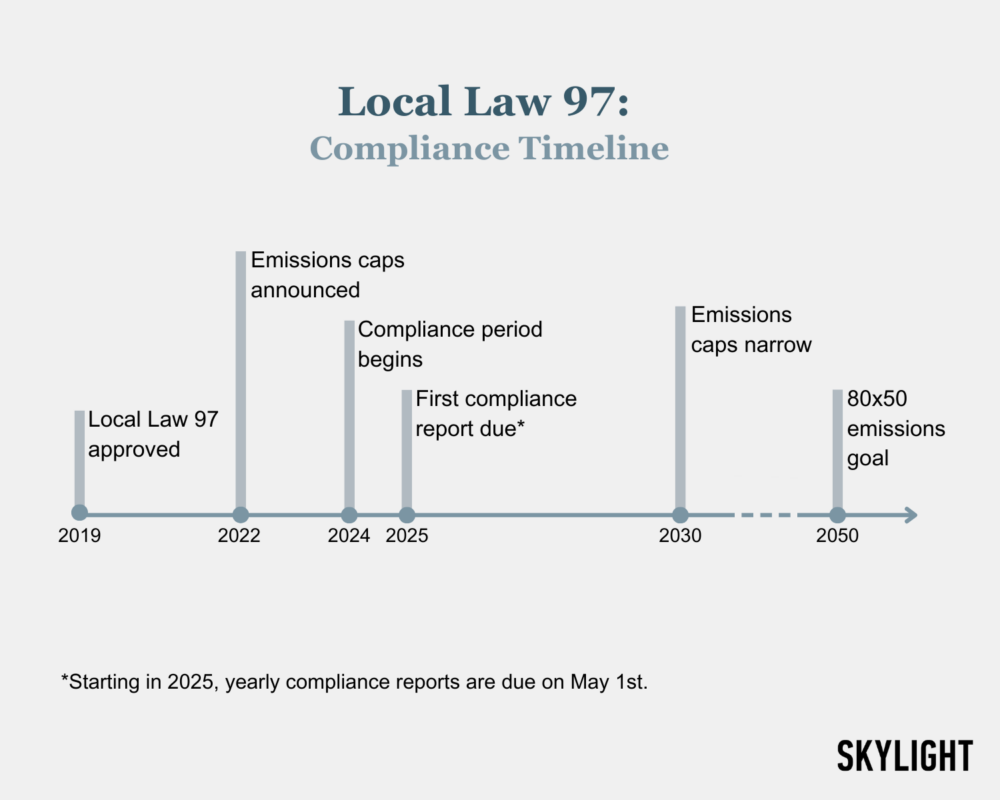
Local Law 97 Compliance Timeline. Skylight
Many residential buildings have already risen to the challenge of transitioning away from oil and gas, often led by homeowners who are especially animated about clean technology, climate change, and conservation. Notwithstanding early progress, the road to LL97 compliance for much of New York City’s aging housing stock is both difficult and costly; many co-ops in particular will “face significant difficulties paying for the system upgrades that LL97 will require,” according to a recent report by the Urban Land Institute. In the years since it’s passed, some stakeholders in New York City real estate have organized to slow down the implementation timeline for the law. In response to this advocacy, members of the city council have proposed new legislation such as Intro 772, which would allow outdoor green space to count toward a building’s overall square footage and thereby reducing the total carbon emissions per square foot without any changes to the building’s use of oil and gas. Others have sued unsuccessfully to repeal LL97 altogether.
One common misconception about LL97 is that it will force all buildings to fully electrify, leaving fuel oil and natural gas behind entirely. Some tactics for decarbonization do involve fully electrifying heating and cooling — heat pumps are a widely-discussed option — but, as Skylight documents, there are many other ways to cut building emissions. Some involve simpler fixes, like installing LED lighting; or focusing on the efficiency of existing systems by installing a building management system to closely control boiler activity; others have re-clad their façade, added insulating covers to their radiators, and adopted hybrid solutions that allowed them to add clean energy heating and cooling while continuing to use their gas-fueled boilers.
Despite contention over the law’s future, most buildings which it covers have in some way responded to it so far: According to POLITICO, the Department of Buildings reported that 94 percent of covered buildings had either filed their LL97 reports, requested an extension, or begun working with the agency to figure out their route to compliance by the beginning of October.
Read more in Skylight’s full explainer about LL97.
NYC mayoral candidates’ stance on Local Law 97, at a glance
While the clean energy transition has not been a major topic in the mayoral campaign, the candidates’ positions on New York City climate policy comes down to two key questions: Whether they support the continuation of the laws at the core of the city’s plans to reduce carbon emissions dramatically over the next fifteen years; and whether they support extending the deadlines for action along the way. Here’s an overview of where each candidate stands.
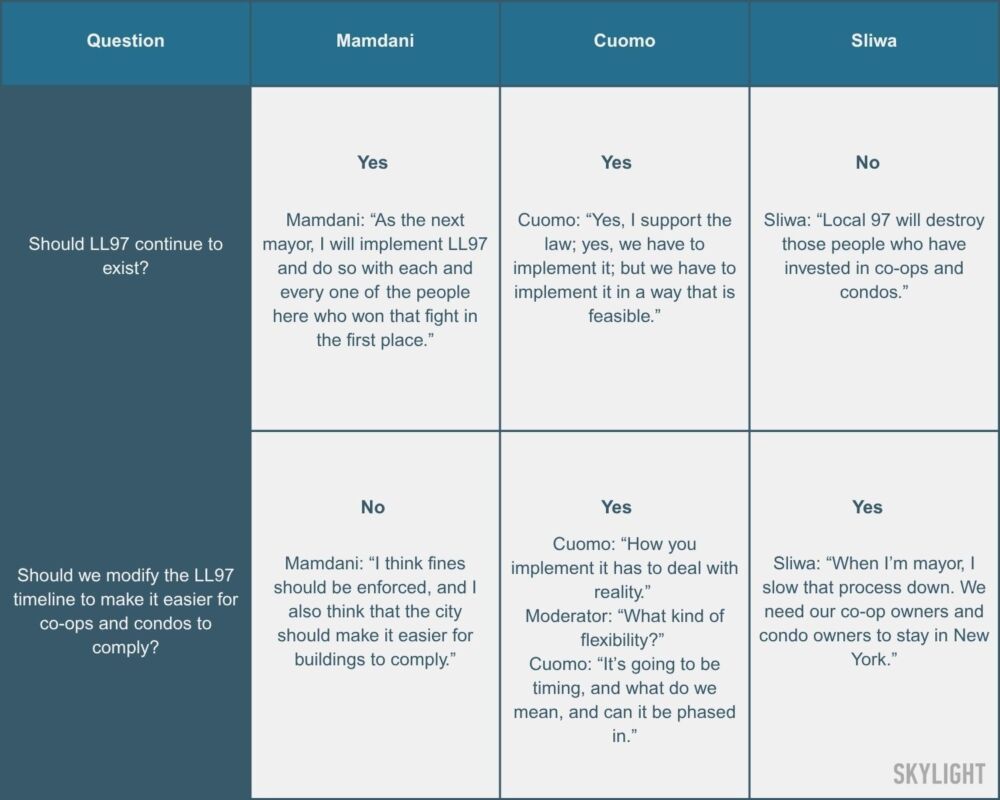
Mamdani, Cuomo, and Sliwa's views on Local Law 97.
Zohran Mamdani’s plan for Local Law 97: Uphold our climate commitments
When frontrunner Mamdani first addressed questions about LL97 at a mayoral forum in February 2025, he spoke fiercely about New York City being in an “existential moment of our climate crisis,” mentioning his widely-circulated promise to freeze the rent in rent-stabilized housing and emphasizing that doing so, along with implementing LL97 fully, would mean “taking on the real estate industry.”
He has not wavered in his conviction that LL97 must be implemented, but since then, his messaging has become more specific — and sympathetic to the interests of the people for whom this law poses real costs. “It is right now easier to pay the fine than to actually comply with this legislation,” he told attendees at the final debate on October 22. “We have to ensure that we make it easier for condo and co-op owners to follow these laws.”
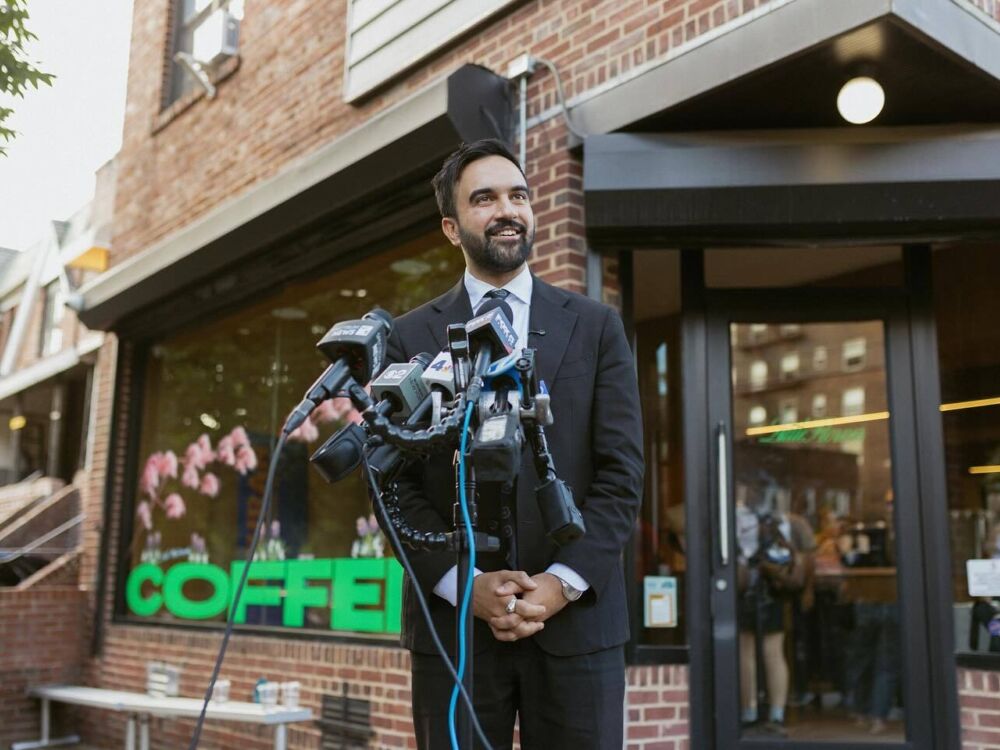
Democratic mayoral candidate Zorhan Mamdani speaks at an August campaign event. Photo: Facebook/ Zohran Kwame Mamdani
He went on to detail his plan for helping residential owners comply, which centers around a more attentive extension of aid from the government. He proposed extending the J‑51 R tax abatement, a tax break for buildings that have taken on large-scale capital improvements that is set to expire at the end of next year, and eliminating its application fees, currently priced at $1000 for an initial application, plus $75 per unit over six units. He also proposed creating a “one-stop shop in city government” that would be in charge of procuring clean energy tech in bulk to drive down prices: “We’ve seen this happen before with clean energy work that’s been done in Woodside houses,” he said at the final debate, referring to NYCHA’s Clean Heat for All challenge, which brought brand-new heat pump technology invented specially for this purpose to its Woodside housing project. (Read more about how the challenge worked in Skylight’s eighth edition.)
A memo outlining Mamdani’s plan for homeowners says that he would have this one-stop shop run out of the NYC Accelerator, which already exists to promote resources and incentives to homeowners, but which the memo calls “understaffed and underfunded” in its current state. According to the memo, it is Mamdani’s view that “it’s cheaper for the Accelerator to buy 10,000 heat pumps and sell them to New Yorkers at cost than it is for 10,000 households to buy that same heat pump at retail prices.”
Overall, Mamdani’s plan is to uphold the city’s commitment to LL97, while making compliance easier for co-ops and condos by making incentives more accessible and driving down the cost of expensive upgrades.
Andrew R. Cuomo’s plan for Local Law 97: Implement it while “deal[ing] with reality”
Cuomo has been significantly less direct in stating his plan for the future of what to do with LL97. In the first debate for the general mayoral election on October 16, Cuomo said affirmatively that he supported LL97, with the caveat that “implementing the law is going to be the key.”
“It has to be done in a way that isn’t so disruptive to businesses and residences that they just give up and pay the fine and don’t even try to comply, which is what is going to happen now,” he said. “It will be cheaper for them to pay the fine than comply. And that obviously will accomplish nothing. So yes, I support the law; yes, we have to implement it; but we have to implement it in a way that is feasible.”
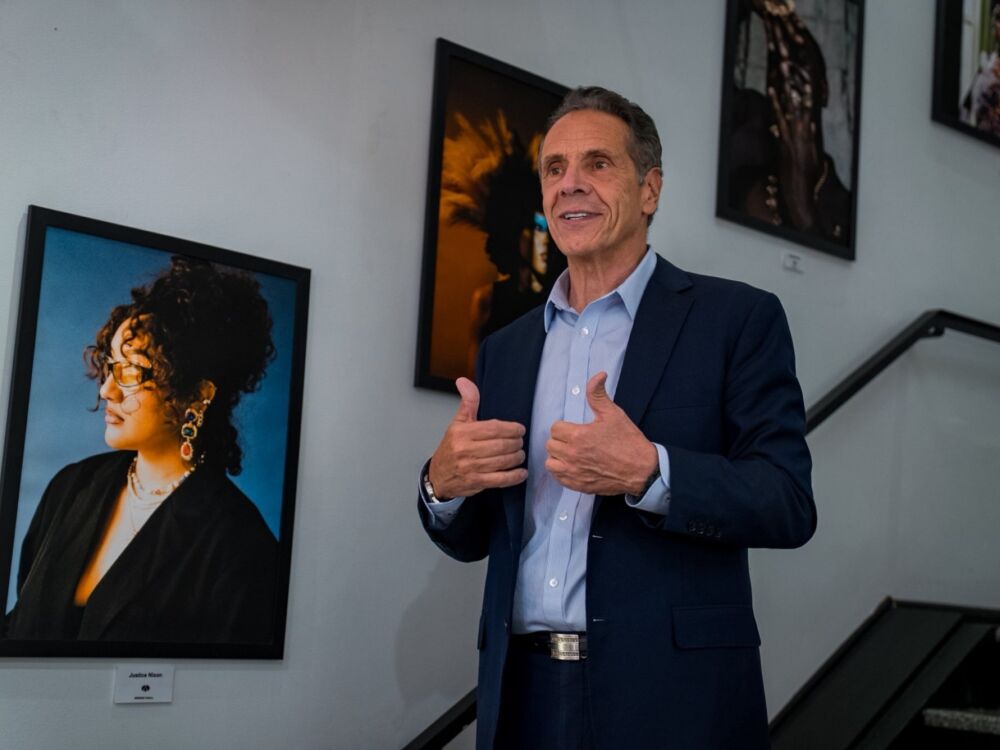
Independent mayoral candidate Andrew Cuomo speaks at an October campaign event. Photo:Facebook/Andrew Cuomo
What “feasible” means to Cuomo and his campaign is not entirely clear. Crain’s reported in May that Cuomo attended a meeting with a coalition of co-op board members where he said that he would be “open to modifying New York City’s landmark climate law that restricts building carbon emissions to go easier on co-op buildings that are struggling to pay for building retrofits to comply with the law,” according to two people who were there. Then, in a statement to the New York Times in July, spokesman Rich Azzopardi said that Cuomo “wants to fix ‘implementation challenges’ by providing more support for building owners, including hardship waivers.”
Still, when pushed by the moderator at the October 22 debate to expand on what he meant by offering additional flexibility to homeowners, Cuomo hedged, saying, “It’s going to be timing, and what do we mean, and can it be phased in.”
In 2021 as governor of New York, Cuomo supported the addition of Renewable Energy Credits (RECs) to LL97, intended to soften the law by giving buildings the ability to purchase credits in order to avoid fines.
In several of the debates, Republican nominee Curtis Sliwa also took pains to point out that Cuomo’s embrace of LL97 might run counter to the precedent he set when he shut down Indian Point, the nuclear power plant supplying significant carbon-free electricity to the city’s grid, in 2021, thereby necessitating a rebound of gas use to generate electrical power for New York City and pushing emissions up by 22 percent. In response, Cuomo maintained that he took action out of concern for public safety.
Curtis Sliwa’s plan for Local Law 97: Repeal it
Sliwa, at the time of publication running in a distant third place, has been unwavering in his opposition to LL97. In a statement to Skylight, Daniel Kurzyna, campaign spokesperson for Sliwa, called LL97 a “disastrous law,” writing: “Curtis Sliwa is the only candidate in this race who is fully opposed to Local Law 97 and has pledged to direct his agency heads to block its enforcement.”
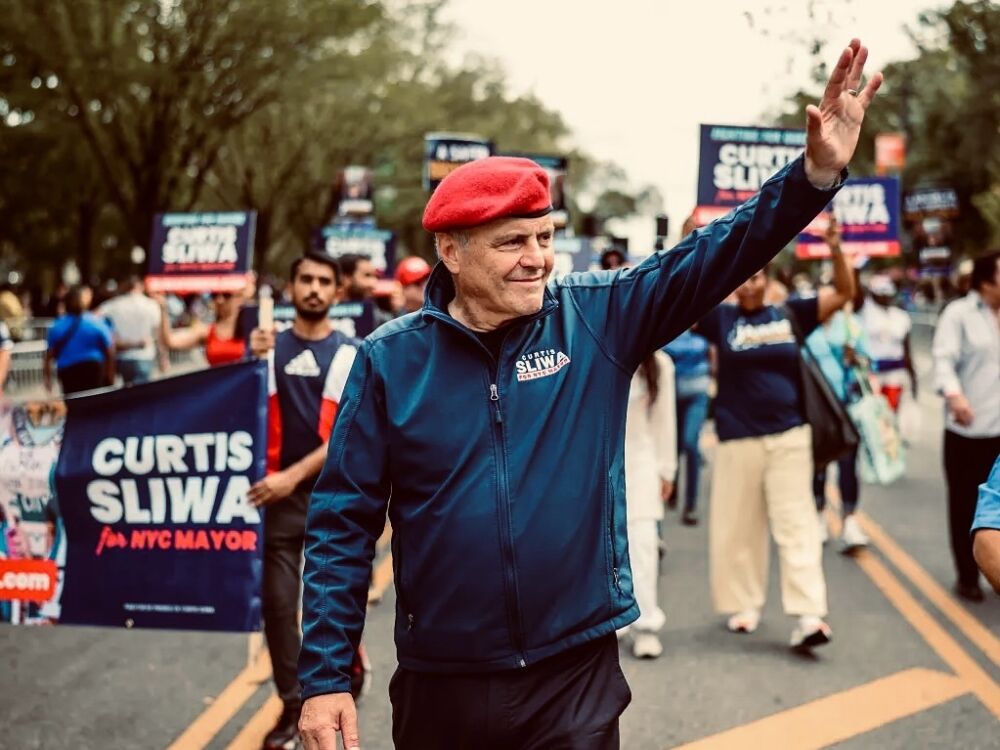
Republican mayoral candidate Curtis Sliwa marches in a parade. Photo: Facebook/Curtis Sliwa
“Now we’re going to force condo and co-op owners to electrify?” Sliwa asked, incredulous, at the October 16 mayoral debate, referencing the misconception that LL97 forces electrification. “Maintenance fees will go up 30 percent. These people will be leaving their condos and co-ops. They need relief. When I’m mayor, I slow that process down. We need our co-op owners and condo owners to stay in New York.”
According to his plan for the first 100 days of his mayorship, blocking enforcement and slowing down the LL97 process would entail first halting implementation of the law. This would look like a collaborative effort between various citywide agencies to pause all penalties, give extensions for “good-faith actors” attempting to comply who have significant roadblocks in their way, and lead an impact audit as well as a “technical assistance program.
The campaigns of Zohran Mamdani and Andrew R. Cuomo did not respond to requests for comment.
